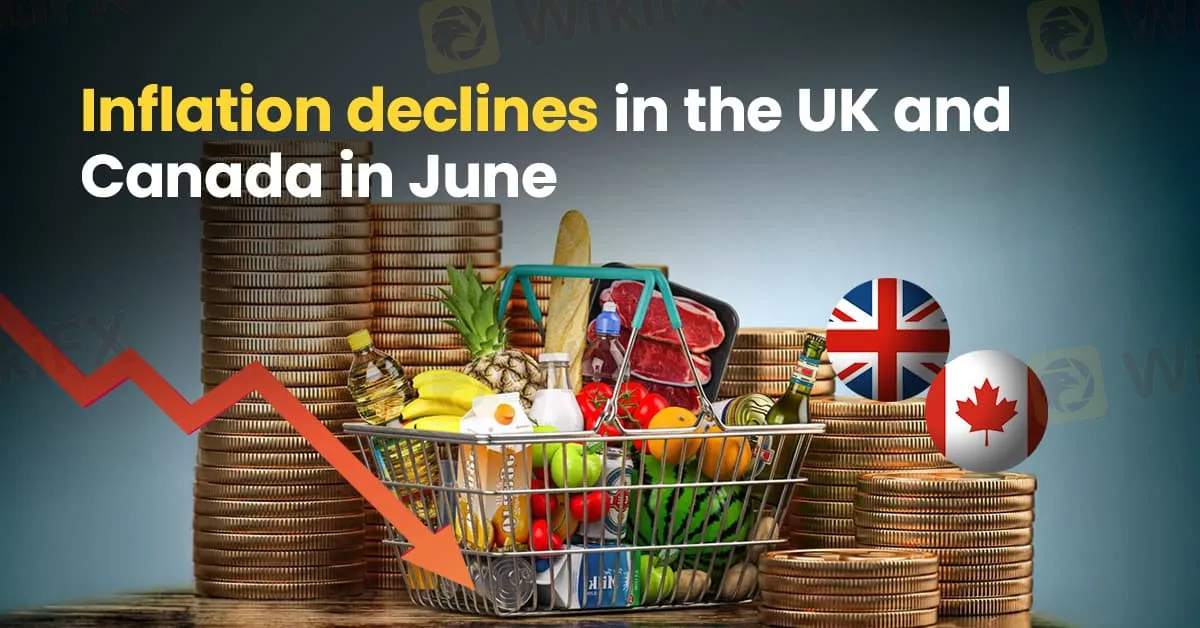Inflation declines in the UK and Canada in June
Abstract:In June, both Canada and the UK experienced a notable decline in inflation rates. This trend aligns with the broader global movement toward lower inflation. The British Pound (GBP) rose sharply against the US Dollar (USD), while Canadian benchmark stock indices showed significant gains.

In June, both Canada and the UK experienced a notable decline in inflation rates. This trend aligns with the broader global movement toward lower inflation. The British Pound (GBP) rose sharply against the US Dollar (USD), while Canadian benchmark stock indices showed significant gains.
Inflation Falls in The UK
In the UK, a positive inflation report pushed the British Pound higher. The CPI remained at 2% year-on-year, unchanged from June, which aligns with the Bank of Englands (BoE) inflation target. Core CPI also remained steady at 3.5% year-on-year. Every month for June, CPI dropped from 0.3% to 0.1%, while core CPI eased from 0.5% to 0.2%.
However, UK services inflation remained unchanged in June at 5.7% year-on-year, nearly three times the BoE‘s inflation target. This persistent high services inflation could complicate the BoE’s plans to lower interest rates.
Inflation Falls in Canada
Canadas Consumer Price Index (CPI) rose by 2.7% year-on-year in June, down from 2.9% in May, matching a three-year low from April. Monthly, CPI posted a 0.1% decline, a sharp drop from the 0.6% increase in May. This was the first monthly decline of the year, primarily driven by a significant reduction in gasoline prices.
However, Core CPI, which excludes food and energy prices, rose by 1.9% year-on-year, slightly up from 1.8% in May. Despite this increase, it remained below the Bank of Canadas (BoC) inflation target of 2%.
Conclusion
These inflation reports indicate a continuing disinflationary trend, which supports the case for interest rate cuts. The Bank of Canada has already lowered rates in June, and it is likely only a matter of time before the Bank of England follows suit.
The USD/CAD currency pair showed little movement in response to the inflation release, while the GBP/USD pair experienced strong gains of 0.52% and 0.67% respectively following the inflation reports.
On the stock market, Canadian benchmark stock indices climbed sharply while UK indices showed a slight decline. The S&P/TSX (Canada) surged 1.07% on Tuesday, rising 243 points to close at 22,995. In contrast, the FTSE 100 (UK) fell by 28 points (0.36%) to 8,136 on Wednesday.
These developments reflect the mixed reactions in financial markets to the evolving inflation landscape in both countries.

Read more

How Inflation Rates Affect Forex Prices Globally
In this article, we’ll explore how inflation affects forex prices globally, the relationship between inflation and currency value, and why traders monitor inflation closely.

PH Financial Sector Grows to P32.3T, Up 10.5% in June
The Philippine financial sector expanded by 10.5% in June, reaching P32.3 trillion. Bank resources surged, while positive earnings drove stock market gains.

US Inflation Cools, But Economic Pressures Still Remain
Inflation shows signs of cooling in the U.S., but persistent economic pressures, particularly housing and utilities, continue to challenge growth.

Philippine PSEI Flat Amid July Inflation and Rate Concerns
Philippine PSEI ends flat as July inflation surge and rate hike concerns weigh on investor sentiment. Broader All Shares Index gains slightly.
WikiFX Broker
Latest News
Zenstox: A Trader’s Nightmare? An Inside Look at Alleged Scams and Unethical Practices
US Presidential Election in Overdrive: Exploring Forex Wealth Codes with WikiFX App
How U.S. Elections Have Influenced Financial Market Trends Since 2000
FCA WARNING AGAINST Touchstone Markets
CySEC Tightens Compliance Rules for Crypto and FX/CFD Brokers
Will Trump's reelection drive more market growth?
Do You Really Know Your Trading Game?
eToro sponsors the Bitcoin Mena Conference
Caroline Ellison Begins Two-Year Sentence for FTX Scandal
FCA Convicts 2 Individuals from CCX Capital & Astaria Group in £1.5M Crypto Scam
Rate Calc
